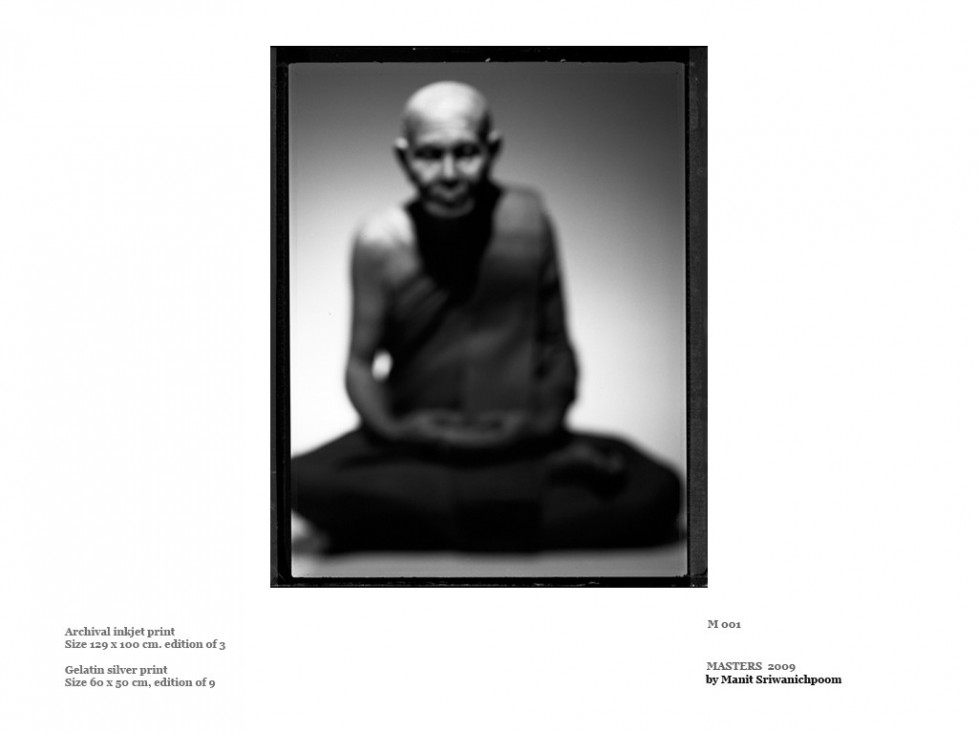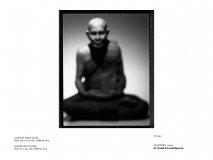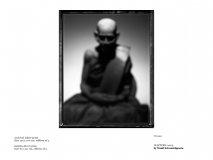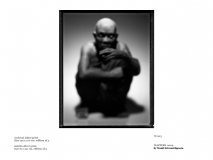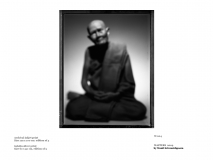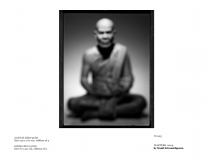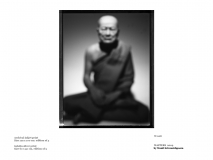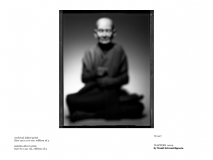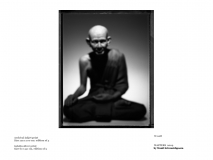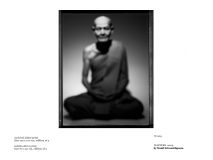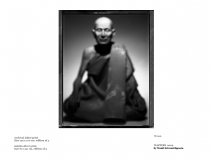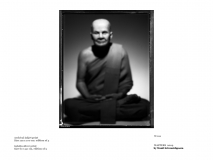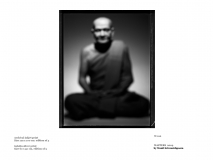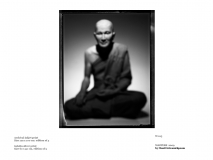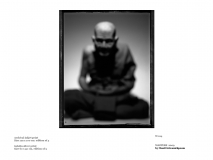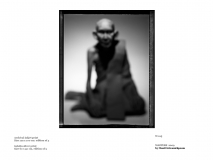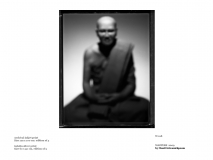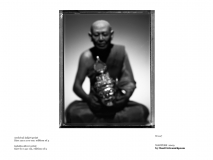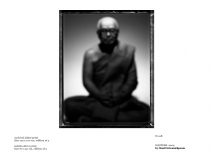MASTERS
By Manit Sriwanichpoom
2009
Held up at a red light one day while driving past religious icon shops around the Giant Swing in Bangkok, I noticed two life-sized statues of monks. One depicted Lhuang Por Toh Brahmarangsi (Holy Father Toh, King Mongkut’s guru, 1788-1872) of Rakhang Temple; the other portrayed to Lhuang Pu Tuad (Holy Grandpa, circa 1582 – 1662) of Chang Hai Temple.
The sight made my skin crawl. They were like living flesh. As if these revered monks had risen from the dead to sit there by the road, to demonstrate their meditation prowess to passers-by.
The creepy feeling deepened when I saw the glass display-case behind them, filled with 30 cm-high replicas of yet more famous monks. These resin miniature humans had been made so life-like by their Thai craftsmen, they rivaled Madame Tussaud’s famous wax figures of celebrities.
Yet one more step by Thai Buddhist commerce in its manufacture of “sacred icons”, deftly copying and appropriating the Western celebrity cult for the Thai ecclesiastical world and its attendant amulet business.
No one knows when the worship of sacred icons of individual Buddhist masters began. In ancient days we worshipped Buddha statues as a symbol of our great teacher and his teachings. The Buddha statue represents a concept rather than an individual. Worship of masters emphasizes specific people and their reputed magical powers for worldly blessings, in direct contradiction to the Buddha’s message of self-reliance and to focus only on the teaching itself.
The more advanced the marketing and production techniques, the more intricate and fantastical their products, it seems to me, the further we travel from the Buddha. Our vision becomes blurry, nothing is clear, including when we look to these holy masters.
เกจิ
มานิต ศรีวานิชภูมิ
2552
วันหนึ่งผมขับรถผ่านเสาชิงช้า ย่านจำหน่ายพระพุทธรูปและเครื่องสังฆภัณฑ์ ระหว่างติดไฟแดงผมหันไปเห็นรูปปั้นพระคล้ายหุ่นขี้ผึ้ง เท่าคนจริงสองรูป; รูปหนึ่งคือ หลวงพ่อโต พรหมรังสี (2331 – 2415)วัดระฆังโฆสิตาราม และอีกรูปคือ หลวงปู่ทวด วัดช้างไห้ (ประมาณ พ.ศ. 2125 –2205)
ผมทึ่งในความสามารถของช่างไทยที่ปั้นได้เหมือนจริงราวกับมีชีวิต ราวกับเชิญท่านมานั่งบริกรรม นั่งสมาธิข้างถนนให้ประชาชนที่ผ่านไปมาได้ชม
ที่น่าประหลาดใจยิ่งขึ้นเมื่อมองไปยังตู้กระจกที่อยู่หลังรูปปั้นพระเกจิทั้งสอง จะเห็นรูปปั้นพระย่อส่วนสูง 30 ซม. เป็นพระเกจิอาจารย์ดังๆที่เรารู้จักคุ้นหน้าคุ้นตา แม้จะเป็นรูปปั้นหล่อด้วยเรซิน (Resin)แต่ช่างไทยก็ทำได้เหมือนคนจริงๆจนน่าประทับใจ
ใช่หรือไม่? นี่คืออีกก้าวหนึ่งของการสร้าง “รูปเคารพศักดิ์สิทธิ์”ของพุทธพาณิชย์ไทยที่รู้จักหยิบยืมลัทธิตะะวันตก“บูชาคนดัง”มาใช้กับวงการพระสงฆ์และพระเครื่องไทย
แต่ก่อนนานมา เราสักการะเพียงพระพุทธรูป, พระพิมพ์ หรือเหรียญ สัญลักษณ์แทนองค์พระสัมมาสัมพุทธเจ้า แล้วเมื่อใดเล่าที่เราเริ่มผนวกรูปเคารพพระสงฆ์เข้าไปด้วย การก้าวเข้าสู่ยุคสมัยใหม่ สมัยรัชกาล 4 พร้อมกับการเข้ามาของเทคโนโลยีการถ่ายภาพ(ความเหมือนจริงและการผลิตซ้ำ) หลวงพ่อโต วัดระฆังนั่งบริกรรมหน้ากล้อง ภาพถ่ายนั้นกลายเป็นภาพศักดิ์สิทธิ์ที่ทุกคนจดจำได้ มีการพิมพ์ซ้ำแล้วซ้ำเล่า เป็นภาพนิยมที่เผยแพร่มากที่สุดในบรรดาภาพเกจิด้วยกัน และกลายเป็นต้นแบบให้ช่างนำไปหล่อโลหะสามมิติในหลากหลายขนาด
วันนี้ด้วยฝีมือและเทคนิคทันสมัย ช่างไทยทำให้หลวงพ่อโตและบรรดาเกจิอาจารย์ดังๆจากภาพถ่ายอดีตกลับฟื้นคืนชีพอีกครั้ง ส่วนเกจิที่ยังมีชีวิต ยังไม่มรณภาพ สามารถทำสำเนาย่อส่วนของท่าน เพื่อให้ผู้ศรัทธาจับจองไว้บูชาได้เช่นกัน
………………………………….


